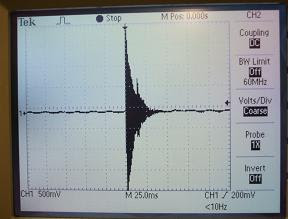
Knocking happens when the advance timing in the enigine, is too advanced. This causes vibrations and movement of the cylinders from side to side. This leads to loss of power and increased engine wear.
The Knock sensors works by sending a voltage to the ECU. The voltage is created by the friction of the peizo crystals inside the knock sensor. When the knocking increases a higher voltage is sent to the ECU which then retards the timing.
I have a 1996 ES300 putting out codes for Knock Sensor. The sensors were quoted me $170/ea. I went over to the shop where they are doing the work, I brought my oscilloscope, and was able to tap the sensor and get the expected waveform, off of each sensor removed from the engine. Your picture is a perfect example of what I saw (and expected to see) and so no need for me to post more pix. I told the mechanic to replace the wire harness and put the original sensors back in. I have every expectation that will fix the problem (it appeared a wire was broken in the harness) and save myself $170 x 2 for taking the time to go over there and test the sensors. They had some dead sensors from other cars at the shop and we tested them, too. They put out a flat line when you tapped them. Methinks there are a lot of sensors sold when a new wire harness is all that's needed. Now hopefully I can finally get this car inspected!
ReplyDelete